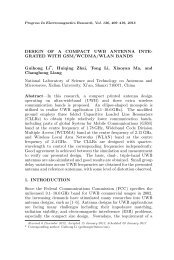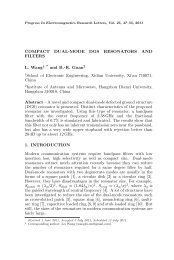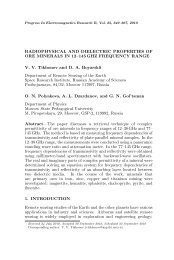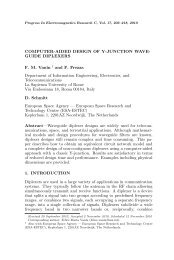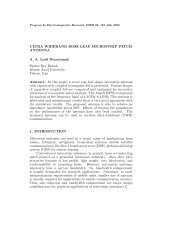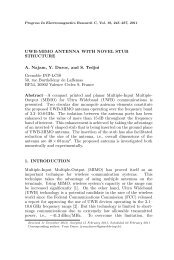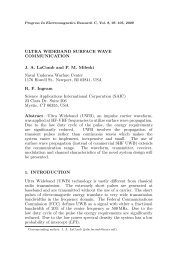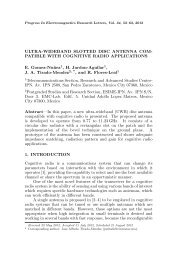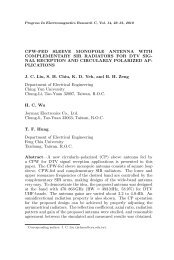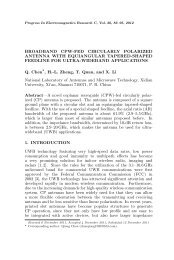a modified uwb wilkinson power divider using delta stub b. - PIER
a modified uwb wilkinson power divider using delta stub b. - PIER
a modified uwb wilkinson power divider using delta stub b. - PIER
Create successful ePaper yourself
Turn your PDF publications into a flip-book with our unique Google optimized e-Paper software.
50 Zhou, Wang, and Sheng<br />
Figure 1. The schematic diagram of the proposed UWB <strong>power</strong><br />
<strong>divider</strong>.<br />
Delta <strong>stub</strong> was first proposed by De Lima Coimbra [9]. Its shape is<br />
an isosceles triangle as Greek letter “Delta”. Although <strong>delta</strong> <strong>stub</strong> has<br />
been proposed for a long time, it is seldom used as impedance match<br />
element in microwave components design. Like radial <strong>stub</strong>, <strong>delta</strong> <strong>stub</strong><br />
can present wider bandwidth. Compared with radial <strong>stub</strong>, <strong>delta</strong> <strong>stub</strong><br />
is a good alternative to be the radial <strong>stub</strong>, and it is useful in wherever a<br />
radial <strong>stub</strong> would be chosen and has simpler contour due to its straight<br />
sides, so it is easier to lay out on PCB.<br />
In the paper, we design an UWB <strong>power</strong> <strong>divider</strong> with <strong>delta</strong> <strong>stub</strong>s.<br />
As far as we know, it is the very first time that <strong>delta</strong> <strong>stub</strong> is used<br />
as impedance match element in <strong>power</strong> <strong>divider</strong>’s design. With the<br />
proposed <strong>delta</strong> <strong>stub</strong>, the overall <strong>divider</strong> length and <strong>stub</strong> size can be<br />
reduced compared with the one in [8], and it is easier for designer to<br />
lay out than a radial <strong>stub</strong>. The simulated and measured results of the<br />
proposed <strong>divider</strong> show good return loss, insertion loss and isolation<br />
performance across the band from 3.1 to 10.6 GHz.<br />
Figure 1 shows the schematic diagram of the proposed UWB <strong>power</strong><br />
<strong>divider</strong> <strong>modified</strong> from the one proposed by Ahmed and Sebak in [8].<br />
Here, single open radial <strong>stub</strong> of each branch is substituted by a <strong>delta</strong><br />
<strong>stub</strong>. The reason for <strong>using</strong> <strong>delta</strong> <strong>stub</strong> instead of radial ones is to<br />
obtain shorter branch line, smaller <strong>stub</strong> and easier layout. By adjusting<br />
dimension parameter of <strong>delta</strong> <strong>stub</strong>, the bandwidth can be broadened.<br />
The impedances of input and output ports of the proposed <strong>power</strong><br />
<strong>divider</strong> are both 50 Ω, and the characteristic impedance of the first and<br />
second branch transmission lines are Z1 = Z2 = 83 Ω. The electrical<br />
lengths of the first and second transmission lines are θ1 = 35.64 ◦ and<br />
θ2 = 29.83 ◦ at the center frequency of 6.85 GHz, respectively. So the<br />
length of branch line (L1 + L2 + Wg) is much shorter than traditional<br />
Wilkinson <strong>power</strong> <strong>divider</strong> with 90 ◦ branch line. Since this <strong>divider</strong> is<br />
symmetric, the even and odd mode analysis can be used to determine<br />
the parameters for the proposed UWB <strong>divider</strong>.





